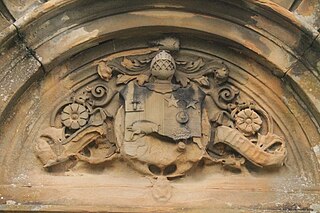
The Sibbald Baronetcy, of Rankelour in the County of Fife, was a title in the Baronetage of Nova Scotia. It was created on 24 July 1630 for James Sibbald. The title became dormant on the death of the second Baronet c. 1680. [1]

The Sibbald Baronetcy, of Rankelour in the County of Fife, was a title in the Baronetage of Nova Scotia. It was created on 24 July 1630 for James Sibbald. The title became dormant on the death of the second Baronet c. 1680. [1]
There have been two baronetcies created for persons with the surname Colquhoun ("Cohoon"), one in the Baronetage of Nova Scotia (1625) and one in the Baronetage of Great Britain (1786).
Nineteen baronetcies have been created for persons with the surname Hamilton, eight in the Baronetage of Nova Scotia, one in the Baronetage of England, five in the Baronetage of Ireland, one in the Baronetage of Great Britain and four in the Baronetage of the United Kingdom. As of 2008 two creations are extant, two are dormant, two are either extinct or dormant and twelve extinct.

There have been four baronetcies created for persons with the surname Baird, two in the Baronetage of Nova Scotia and two in the Baronetage of the United Kingdom.

There have been twenty one baronetcies created for persons with the surname Williams, eight in the Baronetage of England, three in the Baronetage of Great Britain and ten in the Baronetage of the United Kingdom. Only six of the creations are extant as of 2017.
The Douglas of Glenbervie, Kincardine Baronetcy was created on 28 May 1625 in the Baronetage of Nova Scotia.
Viscount of Primrose was a title in the Peerage of Scotland. It was created in 1703 for Sir James Primrose, 3rd Baronet, along with the subsidiary title Lord Primrose and Castlefield. He was the grandson of Archibald Primrose, a Lord of Session under the title Lord Carrington, who in 1651 was created a Baronet, of Carrington in the County of Selkirk, in the Baronetage of Nova Scotia. The peerages became extinct on the death of the third Viscount in 1741. However, the baronetcy was passed on to the late Viscount's cousin James Primrose, 2nd Earl of Rosebery, who became the fifth Baronet of Carrington. He was the son of Archibald Primrose, 1st Earl of Rosebery, fourth son of Sir Archibald Primrose, 1st Baronet. For further history of the baronetcy, see the Earl of Rosebery.
The Richardson, later Stewart-Richardson Baronetcy, of Pencaitland in the County of Haddington, is a title in the Baronetage of Nova Scotia. It was created on 13 November 1630 for Robert Richardson, with remainder to his heirs male whatsoever. The title was dormant from c. 1640–c. 1678, 1752–c. 1783 and 1821–1837. The thirteenth Baronet was the son of Elizabeth, eldest daughter and co-heir of James Stewart, and assumed the additional surname of Stewart.
There have been three baronetcies created for persons with the surname O'Neill, two in the Baronetage of Ireland and one in the Baronetage of the United Kingdom.
There have been seven baronetcies created for persons with the surname Powell, five in the Baronetage of England and two in the Baronetage of the United Kingdom. Only one creation is extant as of 2007.

There have been two baronetcies created for persons with the surname Goring, both in the Baronetage of England. The second creation came into the family through a special remainder in the patent creating the baronetcy. Only the latter creation is extant as of 2008.
There have been three baronetcies created for persons with the surname Foulis, one in the Baronetage of England and two in the Baronetage of Nova Scotia.

There have been four Baronetcies created for persons with the surname Johnston, two in the Baronetage of Nova Scotia, one in the Baronetage of Ireland and one in the Baronetage of the United Kingdom. One creation is extant as of 2010.
There have been four baronetcies created for people with the surname Innes, three in the Baronetage of Nova Scotia and one in the Baronetage of the United Kingdom. Three of the creations are extant as of 2010.
There have been four baronetcies created for persons with the surname Hay, all in the Baronetage of Nova Scotia. Two creations are extinct, one dormant and one extant. A fifth baronetcy in the Jacobite Peerage, although theoretically extant, is not recognised by the Lyon Office.
There have been five baronetcies created for members of Clan Ramsay, four in the Baronetage of Nova Scotia and one in the Baronetage of the United Kingdom. The baronetcy in the Baronetage of the United Kingdom is extant as of 2023.
The Nicolson baronets refer to one of four baronetcies created for persons with the surname Nicolson, all in the Baronetage of Nova Scotia. Two of the creations remain extant as of 2008.

There have been seven baronetcies created for persons with the surname Herbert, three in the Baronetage of England, one in the Baronetage of Ireland and three in the Baronetage of the United Kingdom. All creations are extinct.
There have been two baronetcies created for persons with the surname Macdonnell, one in the Baronetage of Ireland and one in the Baronetage of the United Kingdom. Both creations are extinct.
The Dallison Baronetcy, of Greetwell in the County of Lincoln, was a title in the Baronetage of England. It was created in February 1644 for Robert Dallison, the son of Sir Charles Dallison, an officer in the Royalist Army during the Civil War. Sir Robert was himself a supporter of the Royalist cause. The title became extinct on the death of the fourth Baronet in circa 1720.

The Sibbald, later Scott baronetcy, of Dunninald in the County of Forfar, was created in the Baronetage of the United Kingdom on 13 December 1806 for James Sibbald. The title became extinct on the death of the fifth Baronet in 1945.